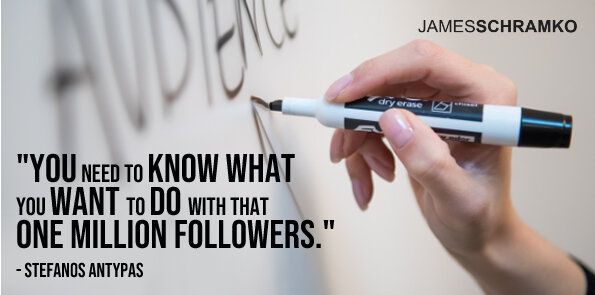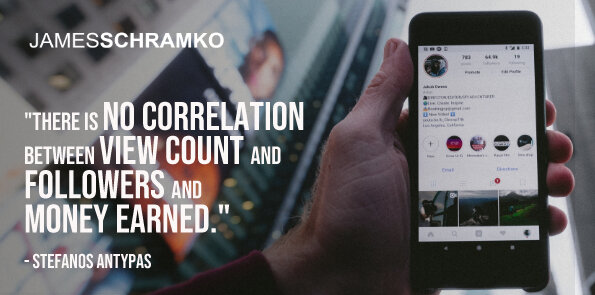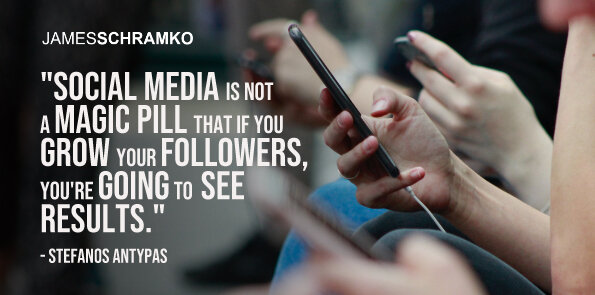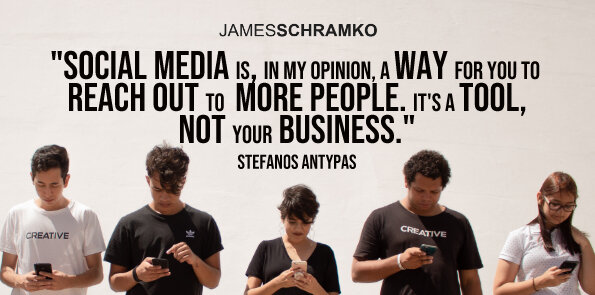Podcast: Download (Duration: 54:14 — 50.4MB)
Get Notified Of Future Episodes Apple Podcasts | Spotify | Amazon Music | Android | Blubrry | Gaana | TuneIn | Deezer | Anghami | RSS | More
When social media videos go viral, it can be a high for the content creator. In the context of business, however, what does it really mean?
James has invited to the show Stefanos Antypas, whose course in social media video creation scored a breakthrough for James, and who is a valued member of the James Schramko community.
James and Stefanos will look at the current trend of social media videos, and what it takes to build social media following.
Stefanos will talk about the actual correlation of views to profit, and the reality of content creator burnout.
And they’ll finish with takeaways for the would-be successful video content creator.
Table of contents
1. A history of trying to do video
2. Where James is at now in his video journey
3. What would one million followers do?
4. Intention and offer
5. It’s not all about the numbers
6. The challenges of trying to make it
7. How much are you willing to invest?
8. You’ve got to do what you love
9. When you want to make videos but not be a YouTuber…
10. If you want to see results in a month…
11. Deep fake versus organic
12. Try not to get too excited…
13. At the end of the day, it’s a tool
A history of trying to do video
James reflects on his journey with video creation, tracing it back to around 2007-2008 when he was inspired by Gary Vaynerchuk’s Wine Library TV.
James made his own attempts to produce videos at a time when internet connections were slow and hosting content was challenging. These initial efforts did not gain much traction, and James abandoned them for a time to pursue audio podcasting. Years later, he revisited video production with improved equipment and guidance.
After several rounds of trying, James’s breakthrough in video content came after attending a course where he learned the intricacies of video scripting, camera settings, and production. This education got him significantly increased viewership, shifting from mere tens of views to thousands.
James thanks a team of advisors that helped his video production journey. These advisors, ranging from camera experts to SEO gurus, have each contributed specialized knowledge, guiding him to produce higher-quality content and better understand the nuances of the video platform.
Stefanos, the course instructor, holds a special place, providing valuable training and ongoing advice.
Now a student of his, James commends Stefanos for his transition from aiding students on tighter budgets to now working with commercial entities who have bigger financial capacities.
Where James is at now in his video journey
James acknowledges that he hasn’t fully harnessed video’s potential, even though he has coached individuals who’ve found significant success on YouTube.
While some target ad revenue from platforms like YouTube as their main business model, James has a different approach. For him, videos, podcasts, and blogs have mostly served as tools to attract customers for his products or affiliate offerings. Yet, he recognizes the potential in expanding his reach through video marketing, which he sees as his next mission.
What would one million followers do?
Stefanos asks, what kind of impact would one million YouTube followers have on James’ business?
James replies that the quality and intent of the followers matter significantly. While he watches various videos online, he doesn’t necessarily have the intention to purchase from those creators. So the type of followers one has determines the financial benefits that might come from avenues like ad revenue or direct sales.
Intention and offer
Stefanos stresses the importance of understanding one’s intent before venturing into social media. Some, he says, might be enticed by the prestige of having a vast following, using it as leverage in professional situations. Much as actors with larger fan bases might have an edge in the industry, this fame can be used as a tool for partnerships and sponsorships.
One should also be clear about what they’re offering on social media. Whether it’s selling viewership numbers to potential partners or building trust with content to drive sales, understanding and catering to the audience’s intent is crucial. Stefanos urges creators to consider and answer vital questions about their goals on social platforms before producing content.
The goal, Stefanos stresses, shouldn’t just be about accumulating followers. While having a large following can create an illusion of authority, it doesn’t guarantee meaningful interaction.
With a dedicated audience, however, the potential paths one can pursue are numerous. It can pave the way for various opportunities, from podcast guesting to speaking engagements.
It’s not all about the numbers
Stefanos shares his experience in the content creation world, having worked with a wide range of creators, from beginners to those with billions of views. He’s observed that there isn’t a direct correlation between the number of views or followers a creator has and the amount of money they earn.
Stefanos has found that many creators with vast followings earn significantly less than those with smaller, but perhaps more engaged, audiences.
While working in Manila with a company specializing in building sales platforms, Stefanos saw this recurring issue: creators with millions of followers earning much less than those with only tens of thousands of followers.
The primary distinction was that creators with smaller followings better understood the intrinsic value of their viewers and could effectively monetize their content.
Stefanos comments too on the fleeting nature of much social media fame. Many creators, he believes, inadvertently find fame and receive financial offers without having the skills to manage their new-found business effectively.
The glamor of the social media industry masks underlying issues, and many don’t have the knowledge needed to ensure long-term success in what they do.
The challenges of trying to make it
Matt Koval, who worked at Google for many years, revealed that up until 2020, the average life expectancy of a content creator was only four years. After gaining popularity and earning money, creators often faced a decline not only in income but also in relevance.
The loss of this relevance could likewise lead to psychological distress, as formerly famous individuals grapple with waning popularity. This could be particularly challenging for those whose identity is tied to their online presence.
In the early 2000s, Stefanos recalls, businesses in Greece were only beginning to see the importance of an online presence. Back then, a company’s legitimacy was often gauged by visibility in directories like the Yellow Pages.
With the rise of social media, businesses now feel pressured to establish a presence on platforms like Instagram and LinkedIn, sometimes without a clear strategy or intent.
James talks of the pitfalls of equating a strong social media presence with business success. Many people, he’s observed, flaunt superficial success symbols like luxury cars, which can be misleading.
Some of these so-called influencers exaggerate their success, renting luxury items or misrepresenting their actual earnings. James warns of not having a solid business structure beneath the facade of social media popularity.
Our two experts touch on the constantly evolving landscape of social media. TikTok’s popularity highlights the potential decrease in a creator’s shelf life to as little as 1.5 years.
James stresses the importance of business intent and strategy. He deliberately avoids platforms that don’t align with his goals. And he and Stefanos agree that while social media can boost a business’s reach, it shouldn’t be mistaken for a sustainable business model.
How much are you willing to invest?
Stefanos addresses the challenges faced by businesses in sustaining their online audience. He emphasizes that it’s not just about expanding follower count but considering the long-term grind and intensity required to maintain such growth.
There’s a need, says Stefanos, to focus on the business’s trust ratings and results, rather than continuously chasing more followers or launching new products.
The constantly changing algorithms of social media platforms present challenges for businesses that rely heavily on these platforms for revenue. Stefanos mentions a media company he worked with, which struggled when an algorithm change reduced the earnings from their videos. They tried to compensate by producing more content, but this proved unsustainable.
Stefanos warns against seeing social media as a quick fix for business problems. While it’s possible to increase followers or reach, this might not address the underlying issues in a business. It’s essential to understand how social media fits within the broader business ecosystem, and then develop strategies aligned with desired outcomes, such as cash flow, employee satisfaction, and work-life balance.
Stefanos also touches on the difference between small creators and big companies. While they might face similar challenges, small creators, new to the industry, often get a dopamine hit from initial successes. What they don’t realize is the consistent effort needed to maintain that success.
You’ve got to do what you love
Again, Stefanos views social media mainly as a tool, not the essence of one’s business. If one does choose to make social media their business, passion for content creation is crucial. He cites as example Cassandra, a content creator from Mexico, who genuinely enjoys videography and editing, making the process natural and authentic for her.
James agrees that many successful individuals on social media, like Scott Devine with his bass guitars and Sorelle with her art, are driven by their passions. Pat Flynn, with his Pokémon channel, is someone rediscovering his child-like joy and enthusiasm, turning it into a successful venture.
Stefanos and James both recognize Gary Vee’s exceptional skills in content creation. Gary’s unparalleled understanding of social media and his constant drive to teach and improve make him stand out in the industry. His unique approach and vast experience, combined with his commitment to producing high-quality, short-form content, set him apart from others.
James emphasizes the importance of targeting the right audience rather than chasing numbers. He believes in focusing on those who resonate with his content and can genuinely benefit from what he offers. Acknowledging that not all viewers or listeners will convert into customers, James prioritizes creating value and ensuring his actual buyers find his content beneficial.
When you want to make videos but not be a YouTuber…
For those who want to use social media videos as a tool but have no desire to become full-time YouTubers, Stefanos emphasizes the importance of understanding the nature of the product or service they’re offering.
If one is selling low-ticket items that require volume sales, it may be more efficient to use ads, especially when starting from scratch. This quickly places the product before potential buyers without the uphill battle of building organic reach from zero.
James adds that well-performing organic content can be further amplified with paid ads.
For those selling high-ticket items where fewer but more significant sales are needed, Stefanos likens social media to an elaborate phonebook or Yellow Pages. Rather than cold-calling or emailing, one can use platforms to gauge potential client compatibility through their profiles and interactions.
Stefanos’s personal experience underscores the potential of this approach: even with fewer than 1000 subscribers, he leveraged his social media know-how to generate significant income and create valuable connections. His success didn’t come from a massive follower count, but from genuine connections and showcasing his expertise through his social media portfolio.
If you want to see results in a month…
To see tangible results within a month on social media, Stefanos suggests creating a clear and compelling profile that reflects both your personality and your offer. Then, by actively reaching out to individuals, genuine engagement can be achieved.
Stefanos recommends spending five minutes per day reaching out to five real accounts on LinkedIn, Facebook or Instagram. Reach out, send a message, and say something meaningful, he says. Not many take this direct approach, but those who do tend to see rapid results within a month.
James warns against the common tactic of flattery messages. He shares an instance where he received one such message, from someone claiming to help coaches and agencies make $100K a month. He inspected the sender’s profile – it had 567 followers and nine posts.
Stefanos mentions that stories, especially on platforms like Instagram, offer a more genuine way to connect with users. Responding or reacting to someone’s story can initiate genuine conversation. James adds that when users share or appreciate his work in their stories, he is more likely to share it further, as it’s a direct and credible nod to his efforts.
Deep fake versus organic
James tells of an account he came across where the content creator used deep fake technology, with AI generating everything from the script to the video’s visuals. This account had videos that garnered up to 600K views, but a closer look showed repetitive content, mostly centered around deep fakes or lists of websites to patronize or avoid.
James predicts a surge in automated deep fake content, likening it to previous automated web techniques.
Stefanos, on the other hand, believes that while there will inevitably be an influx of poor-quality, automated content, discerning audiences will eventually distinguish between hastily-made content and that created with genuine intent. He draws parallels to industries where automation has led to cheaper but less durable products, and says that automation tools can be harnessed for better quality work when used appropriately.
James is currently focusing more on organic content creation. He recalls the early days of the internet where tools created mass, low-quality web pages, and believes that just as those were eventually weeded out, deep fake content will face similar scrutiny. He asserts the importance of personal, organic content, especially given the rise of deep fakes.
Ultimately, James and Stefanos agree that quality content will always find its audience.
Try not to get too excited…
Stefanos expresses concern over content creators getting overly focused on video views and becoming trapped in the vicious cycle of chasing virality. Success, he stresses, isn’t always a steady climb. There’s a misconception that having a couple of hits means it’s all up from there.
He also emphasizes that while some creators might strike gold early on, consistent success requires calculated decisions and attention to data.
James agrees that the success of a few videos shouldn’t be over-generalized. It takes a large volume of content to truly gauge what works and resonates with the audience. He himself is continually experimenting and iterating to improve, knowing the importance of persistence and the long game in content creation.
Stefanos also highlights the emotional stakes involved in content creation. He’s observed many creators who pin their hopes on platforms like TikTok as an escape from their current circumstances. While he acknowledges the potential financial gains of successful content, he suggests creators keep a balanced perspective and not anchor their emotional wellbeing on their social media success.
James has likewise seen the emotional toll, especially on younger influencers, who might feel the pressure to project a perfect life. Surprisingly, James’s prime and most successful audience has been 25- to 35-year-olds, of the likes of Chandler Bolt, Ezra Firestone, Ryan Levesque, and James Dyson, a demographic that can be found on platforms such as YouTube and Instagram.
At the end of the day, it’s a tool
Stefanos reiterates that social media should be viewed merely as a tool, not a guaranteed path to success. Although the digital age offers more opportunities for individuals to gain visibility, relying solely on platforms like TikTok or Instagram for success can be precarious. He stresses the randomness of algorithms, noting that even tech giants like Meta struggle to fully comprehend them.
James agrees, pointing out the failure of companies like Google that have tried to crack the social media code.
James intends in his own business to persevere, hoping to leverage the platforms to complement his core business. He does believe in the potential benefits of engaging with social media, inspired by the evident joy and success some of his clients have found on these platforms.
If you’ve found this talk interesting and want more of Stefanos, you can find him on Instagram, LinkedIn and his website, successfulcontentcreator.com.
Stefanos has a new two-week intensive program set to launch soon, aimed at helping individuals with branding and crafting a solid social media strategy for the upcoming year, ensuring that participants spend less time on social media and more on their primary business ventures.
Liked the show? Leave us a review on iTunes













Leave a Reply